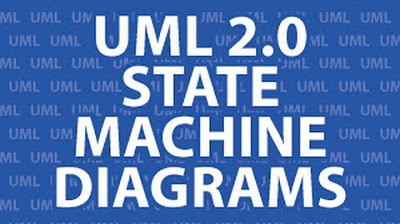Lecture 27: Sequence Diagram - II
Summary
TLDRThis session focuses on UML 2.0 sequence and collaboration diagrams, highlighting their importance in automating method population and code generation. The concept of frames, introduced in UML 2.0, enhances sequence diagrams by improving expressiveness and clarity, especially for use cases with multiple interactions. The session also covers the transition to activity diagrams, a tool for representing workflows and complex use cases. It explores the generation of both sequence and communication diagrams from each other and explains how UML tools simplify this process. The session concludes with an introduction to activity diagrams, useful for mapping out use case steps.
Takeaways
- 😀 Sequence diagrams help automatically populate methods in classes and generate significant code, saving time in the design process.
- 😀 UML 2.0 introduced frames in sequence diagrams, improving their expressiveness and making interactions more clear and elegant.
- 😀 The loop operator in sequence diagrams allows for repeated actions (e.g., adding and reserving items) to be captured effectively, which was not possible in UML 1.x.
- 😀 The introduction of frame operators like 'alt' (conditional logic), 'loop' (repeated actions), and 'opt' (optional actions) enhances the flexibility and clarity of sequence diagrams.
- 😀 Collaboration diagrams, now called communication diagrams in UML 2.0, show the relationships between objects and the sequence of message exchanges using numbered flows.
- 😀 Sequence diagrams have an implicit time axis (top to bottom), while communication diagrams use numbered message flows to represent the order of interactions.
- 😀 It is easy to generate a communication diagram from a sequence diagram by translating object interactions and their sequence of messages into the appropriate format.
- 😀 Code can be generated directly from sequence diagrams, which helps in identifying necessary methods and class structures based on the interactions shown.
- 😀 Activity diagrams are used to represent workflows and complex use cases, showing sequential and parallel activities and their transitions.
- 😀 While similar to flow charts, activity diagrams offer more sophistication, supporting synchronization and complex branching of activities for comprehensive system modeling.
Q & A
What is the importance of sequence diagrams in software design?
-Sequence diagrams help in populating methods in classes automatically, aiding in code generation. They make it easier to allocate methods to classes and generate substantial portions of code, although the complete code still needs refinement.
How does UML 2.0 enhance sequence diagrams compared to UML 1.x?
-UML 2.0 introduced frames, which significantly improve the expressive power and clarity of sequence diagrams. Frames allow for the representation of complex interactions, such as loops and conditionals, which were not possible in UML 1.x.
What role do frames play in sequence diagrams in UML 2.0?
-Frames in UML 2.0 allow for better organization and clarity. They can represent constructs such as loops, conditionals (opt, alt), and parallel executions, which enhance the ability to represent complex interactions and use cases effectively.
What does the 'loop' operator in UML 2.0 sequence diagrams represent?
-The 'loop' operator represents repeated interactions in sequence diagrams. For example, in an e-commerce scenario, adding multiple items to a cart and reserving them in the inventory could be represented by a loop, where each item added triggers a reservation process.
Why are return arrows often omitted in sequence diagrams?
-Return arrows are typically omitted in sequence diagrams unless explicitly needed for clarity. This reduces clutter and makes the diagram more elegant. Return values are often understood implicitly unless required for a specific purpose.
What are some of the frame operators used in sequence diagrams, and what do they represent?
-Some frame operators in UML 2.0 include 'alt' (for if-then-else), 'opt' (for optional conditions), and 'loop' (for repeated actions). These operators allow for more sophisticated control flows, such as conditionally executed interactions or repeated sequences.
What is the difference between a sequence diagram and a collaboration (communication) diagram?
-While sequence diagrams focus on the order of interactions over time, collaboration diagrams (now known as communication diagrams in UML 2.0) focus on the structural relationships between objects and the sequence of messages exchanged between them.
How can sequence diagrams be transformed into collaboration diagrams?
-To transform a sequence diagram into a collaboration diagram, list the objects at the top and assign them unique IDs. Then, read the sequence of interactions from top to bottom and draw the appropriate association lines with message numbers to represent the flow of communication between objects.
What is the purpose of an activity diagram in UML?
-An activity diagram represents the workflow of a complex use case, showing how different actions or steps occur, including sequences, parallel activities, and transitions between states. It is useful for visualizing complex behaviors and generating test cases.
How does an activity diagram differ from a flowchart?
-While both activity diagrams and flowcharts represent processes, activity diagrams in UML are more sophisticated and capable of depicting complex behaviors, such as parallel execution and synchronization. They provide a higher level of abstraction and are better suited for software modeling.
Outlines

هذا القسم متوفر فقط للمشتركين. يرجى الترقية للوصول إلى هذه الميزة.
قم بالترقية الآنMindmap

هذا القسم متوفر فقط للمشتركين. يرجى الترقية للوصول إلى هذه الميزة.
قم بالترقية الآنKeywords

هذا القسم متوفر فقط للمشتركين. يرجى الترقية للوصول إلى هذه الميزة.
قم بالترقية الآنHighlights

هذا القسم متوفر فقط للمشتركين. يرجى الترقية للوصول إلى هذه الميزة.
قم بالترقية الآنTranscripts

هذا القسم متوفر فقط للمشتركين. يرجى الترقية للوصول إلى هذه الميزة.
قم بالترقية الآنتصفح المزيد من مقاطع الفيديو ذات الصلة

Systems Analysis and Design 06: Process Specification & Structured Decision

Introduction to UML

UML 2 State Machine Diagrams

Cara Mudah Memahami Usecase Diagram pada Matakuliah RPL

15 Minute Full Body Strength Flow | Daily Practice Yoga Flow | English

Apa itu UML? Beserta Pengertian dan Contohnya | Belajar UML & Perancangan Sistem
5.0 / 5 (0 votes)
